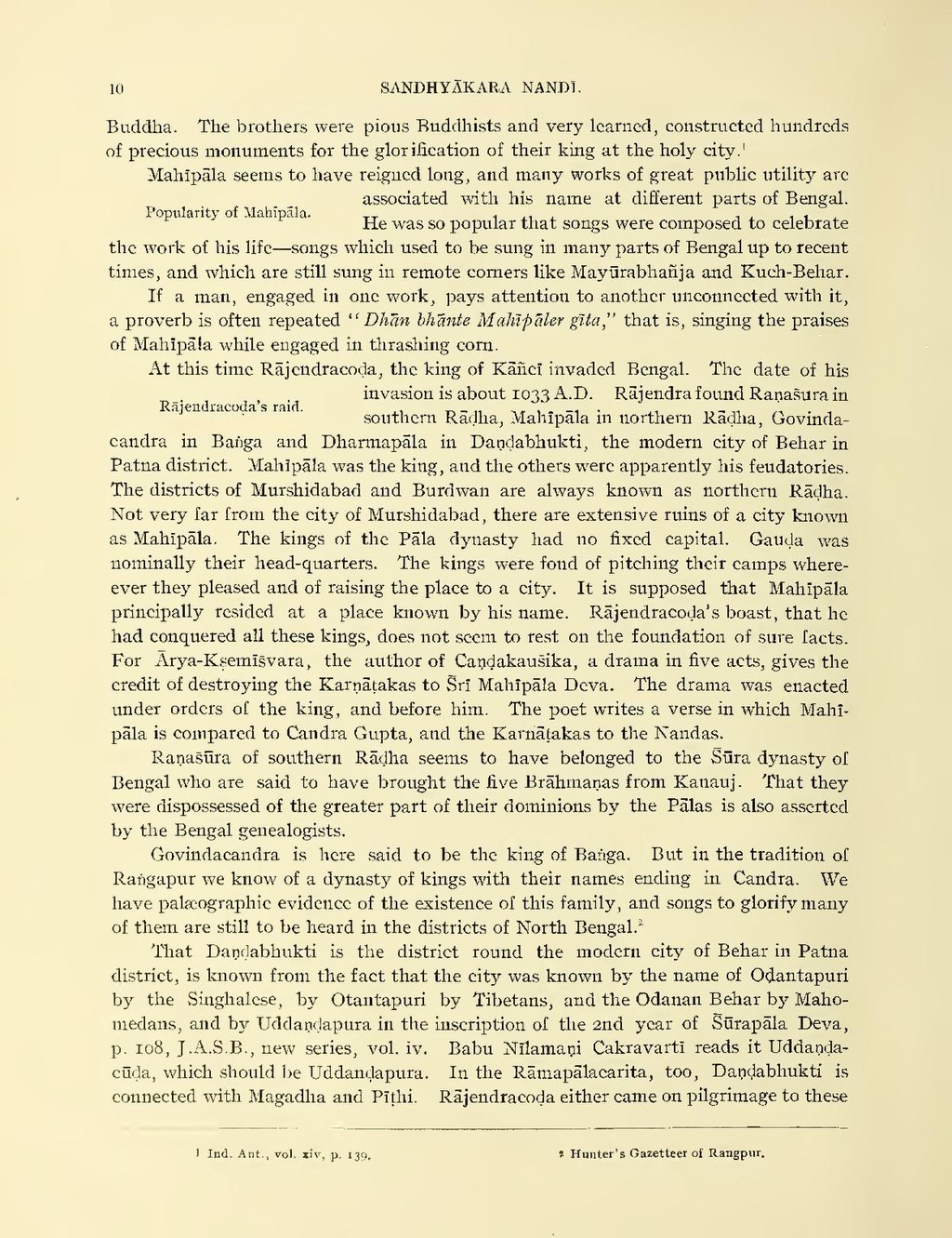10 SANDHYAKARA NANDI. Buddha. The brothers were pious Buddhists and very learned, constructed hundreds of precious monuments for the glorification of their king at the holy city.' Popularity of Mahipala. Mahipala seems to have reigned long, and many works of great public utility are associated with his name at different parts of Bengal. He was so popular that songs were composed to celebrate the work of his life-songs which used to be sung in many parts of Bengal up to recent times, and which are still sung in remote corners like Mayūrabhañja and Kuch-Behar. If a man, engaged in one work, pays attention to another unconnected with it, a proverb is often repeated "Dhan bhante Mahipaler gita," that is, singing the praises of Mahipala while engaged in thrashing corn. Rajendracoda's raid. At this time Rajendracoda, the king of Kanci invaded Bengal. The date of his invasion is about 1033 A.D. Rajendra found Raņasura in southern Radha, Mahipala in northern Radha, Govinda- candra in Banga and Dharmapala in Daṇḍabhukti, the modern city of Behar in Patna district. Mahipala was the king, and the others were apparently his feudatories. The districts of Murshidabad and Burdwan are always known as northern Radha. Not very far from the city of Murshidabad, there are extensive ruins of a city known as Mahipala. The kings of the Pala dynasty had no fixed capital. Gauda was nominally their head-quarters. The kings were fond of pitching their camps where- ever they pleased and of raising the place to a city. It is supposed that Mahipala principally resided at a place known by his name. Rajendracoda's boast, that he had conquered all these kings, does not seem to rest on the foundation of sure facts. For Arya-Ksemisvara, the author of Candakaušika, a drama in five acts, gives the credit of destroying the Karnāṭakas to Sri Mahipala Deva. The drama was enacted under orders of the king, and before him. The poet writes a verse in which Mahi- pāla is compared to Candra Gupta, and the Karnāṭakas to the Nandas. Ranašūra of southern Radha seems to have belonged to the Süūra dynasty of Bengal who are said to have brought the five Brāhmaṇas from Kanauj. That they were dispossessed of the greater part of their dominions by the Palas is also asserted by the Bengal genealogists. Govindacandra is here said to be the king of Banga. But in the tradition of Rangapur we know of a dynasty of kings with their names ending in Candra. We have palæographic evidence of the existence of this family, and songs to glorify many of them are still to be heard in the districts of North Bengal.² That Dandabhukti is the district round the modern city of Behar in Patna district, is known from the fact that the city was known by the name of Odantapuri by the Singhalese, by Otantapuri by Tibetans, and the Odanan Behar by Maho- medans, and by Uddandapura in the inscription of the 2nd year of Surapala Deva, p. 108, J.A.S.B., new series, vol. iv. Babu Nilamani Cakravarti reads it Uddanda- cūḍa, which should be Uddanḍapura. In the Rāmapalacarita, too, Dandabhukti is connected with Magadha and Pithi. Rajendracoda either came on pilgrimage to these 1 Ind. Ant., vol. xiv, p. 139. 2 Hunter's Gazetteer of Rangpur.

